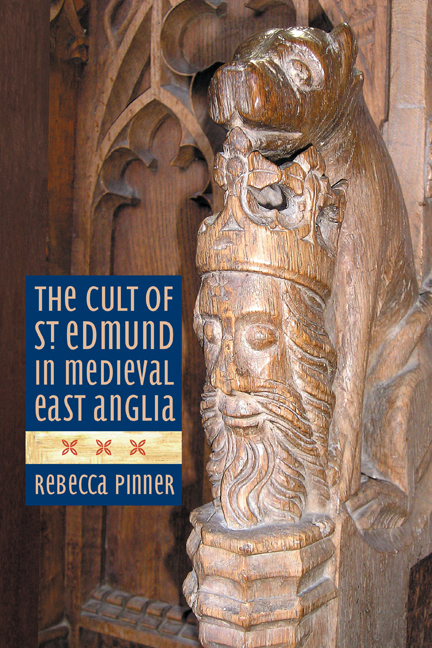Book contents
- Frontmatter
- Contents
- List of Illustrations
- Acknowledgements
- Abbreviations
- Introduction
- Part I Texts and Contexts: the Legend of St Edmund
- Part II Relics, Shrines and Pilgrimage: Encountering St Edmund at Bury
- Part III Beyond Bury: Dissemination and Appropriation
- Conclusion: ‘Martir, Mayde and Kynge’, and More
- Appendix 1 Synoptic Account of the Legend of St Edmund
- Appendix 2 Chronology of Significant Events and Texts Associated with the Cult of St Edmund
- Bibliography
- Index
Chapter 2 - De Miraculis Sancti Eadmundi: Herman, Osbert and Samson
Published online by Cambridge University Press: 21 May 2021
- Frontmatter
- Contents
- List of Illustrations
- Acknowledgements
- Abbreviations
- Introduction
- Part I Texts and Contexts: the Legend of St Edmund
- Part II Relics, Shrines and Pilgrimage: Encountering St Edmund at Bury
- Part III Beyond Bury: Dissemination and Appropriation
- Conclusion: ‘Martir, Mayde and Kynge’, and More
- Appendix 1 Synoptic Account of the Legend of St Edmund
- Appendix 2 Chronology of Significant Events and Texts Associated with the Cult of St Edmund
- Bibliography
- Index
Summary
ONCE introduced to the devotional consciousness through the creation of a successful passio, a nascent cult was more often than not confirmed and consolidated by the compilation of miracles attributed to the holy individual. Miracles serve as evidentiary proofs of saintly status and a means of defining an individual in relation to established, particularly biblical and early Church, patterns of sanctity, and are thus integral to the establishment of a hagiographic tradition. Thus, when Abbo claims that the discoverers of Edmund's head ‘recognised in the most blessed Edmund a worthy parallel to that enviable man who, unharmed among the gaping jaws of hungry lions, laughed to scorn the threats of those who had plotted his destruction’, he credits both Edmund's subjects and the readers of the Passio with the ability to recognise the allusion to Daniel's miraculous escape from the lions’ den. The fact that this is a ‘worthy’ comparison to an ‘enviable’ man demonstrates the function of miraculous cross-referencing in the creation of a saintly typology. Abbo recounts a number of posthumous miracles attributed to Edmund. Indeed, it was Edmund's miracle-working reputation which led to the recognition of his sanctity and his translation to Beodricesworth.
In addition to miracles found in saints’ lives, narratives were collected together and recorded in single volumes. These were similarly intended to demonstrate the saint's power, whether for the purposes of promoting pilgrimage to their resting place or of applying for official canonisation, but could also perform a subtly different function in the creation and dissemination of a cult. Often recorded by the keepers of a shrine, books of miracles were frequently kept on or near the shrine itself. They formed a tangible link between the textual and physical cult and a means of demonstrating to pilgrims the present power of a saint. Thus the compilation of Edmund's miracles marked a significant stage in the development of his cult.
Herman archdiaconi, liber de miraculis sancti Eadmundi
The first collection of Edmund's miracles is De Miraculis Sancti Eadmundi, which records Edmund's deeds up to 1096. The immediate context was Abbot Baldwin's rebuilding of the abbey church, into which St Edmund was translated in April 1095.
- Type
- Chapter
- Information
- The Cult of St Edmund in Medieval East Anglia , pp. 48 - 62Publisher: Boydell & BrewerPrint publication year: 2015

